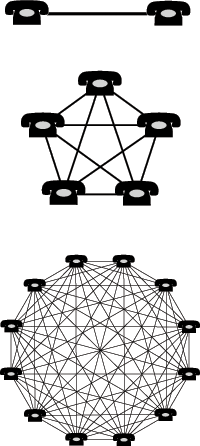As marketers adopt more and more marketing technology in their work, particularly cloud-based applications, with many choices and many different opinions about what software is best for a particular purpose, the question arises:
To what degree should marketing applications be centralized or standardized within an organization?
This question usually arises from the bastions of the besieged IT department that pictures many different marketers buying many different software packages on their own, all willy-nilly in the cloud, to be a nightmare of gargantuan proportions. To regain control of that chaos, they make the case for why all technology — and marketing technology is no exception, in their opinion — should be centralized. In the IT department, naturally. (My Chief Language Officer Parable takes this to an absurd extreme.)
But in a world of software-as-a-service and agile marketing, I’m not convinced that the rationale for centralized IT control of all applications — which was largely etched in stone by the early 90’s before the Web — still holds true today.
One of the main arguments for centralization is that it “reduces cost.” The justification for this claim is usually based on three ways the organization can save money:
1. Eliminating redundant (or semi-redundant) software purchases. If Group A uses Software X, then when Group B wants to do something similar, they can just use Software X too — and avoid spending money on a separately negotiated copy of Software X, or worse, a different Software Y.
2. Negotiating better pricing as they scale up. If Software X charges per person, or by some other factor related to scale, then combining Group A and Group B under the same umbrella gives them more bargaining power and economies of scale in purchasing.
3. Leveraging knowledge already acquired about operating the software. The company went through a learning curve to get Group A running on Software X. Group B can benefit from this experience — but only if they stick with Software X. If they go with Software Y, it’s a brand new learning curve.
A fourth source of cost reduction in centralization used to be shared technical infrastructure — fewer different pieces of software, running on fewer machines, were easier and cheaper to maintain. But now that most marketing-related software is provided “on demand” via the cloud, this is not necessarily a factor.
I’ll be the first to admit: these are legitimate ways to reduce costs.
But if you’re going to argue for minimizing costs with your organizational strategy, you really should consider all costs. Centralization doesn’t come for free. Let’s consider some of the costs that centralization can impose:
- the administrative overhead of centralization: the staff and other resources that go into maintaining and enforcing centralization, including all those meetings and emails back-and-forth;
- delays in adopting new software because it has to go through approval and negotiation by the “centralization police” — this extra time may be very precious in a fast-moving, competitive market;
- the cost of not being able to use features provided by competitors of the pre-chosen vendor in a particular circumstance where the competing product would be better suited;
- the cost of reduced passion and creativity.
It’s this last cost that I believe is the largest and most insidious.
Expenses only matter relative to revenues
But wait, you might object, many of those costs I’ve listed are “opportunity costs” — they aren’t real costs. They don’t appear as line items in an expense report. How do you quantify passion and creativity?
This goes to the heart of the fallacy that “centralization is always good” because of hard-cost cutting.
A business doesn’t care about expenses. Really. A business cares about expenses relative to revenue. If you can (A) spend $5 and make $10, or (B) spend $6 and make $15 — which would you choose? You’d be daft to pick (A), even though its expense is less than (B).
Now, while that’s obvious in our stylized example, in real businesses it’s all too easy to lose sight of the connections between expenses and revenues. Middle management incentives can really muck this up, when someone is rewarded for cutting costs without necessarily realizing the consequences those “savings” have elsewhere in the business.
Marketing is powered by passion and creativity. The difference between mediocre and brilliant marketing — the kind of marketing that grows revenues in a competitive world — is inspired ideas, in particular, inspired ideas that can be carried across the finish line. Such innovation is immensely valuable, but it’s hard to achieve. You want to do everything you can do to inspire your marketing team and enable them to turn those inspirations into successful programs.
Shaving a few dollars at the cost of such inspiration can be a bad trade-off.
So if someone in marketing is excited to experiment with a new web analytics package, say Chartbeat, even though the IT department had already standardized on something else, say Coremetrics, is the $50/month extra worth it?
In a centralization-dominated organization, the answer would be flat-out “no.” But in an enlightened organization that is as hungry for growth as it is economy, the answer is “maybe.”
More importantly, it’s a decision that should be made within marketing. Marketing should spend a certain amount of its budget on discretionary marketing technology to find new inspiration and innovation. Like advertising, some will work, some won’t. But the failure to experiment is a recipe for death by stagnation and attrition.
Similarly, while “leveraging knowledge” of existing packages is a potential cost savings, I’d also make the case that new learning is valuable too. Especially when changes are happening so rapidly in marketing overall — beyond the walls of any one organization — it can be good to get fresh perspective and try a new approach or a new methodology enabled by a different software package.
The true value of centralization
However, while I’m skeptical of centralizing marketing technology primarily to cut costs, there can be value-creation reasons for centralization too.
Some of the best reasons for centralization are positive network effects. The classic example of this (via Wikipedia) is the telephone. The more people who have telephones, the more useful everyone else’s telephone is, because they can reach more people. The growth in value from such network effects is often defined by Metcalfe’s Law.
A CRM is a terrific example of a marketing technology that typically generates a lot of value from centralization. If everyone in the organization shares information about customers through a common platform, it generates tremendous value in coordinating efforts across multiple groups and departments and delivering consistency to customer experiences. Even if individual teams might have preferred the features of a different CRM, the benefits of standardization usually outweigh them… in this case.
But such positive network effects are only valid in cases where “sharing” really does deliver value. For instance, you might insist that everyone use the same web content management (WCM) platform. But if you have multiple sites for different audiences — or outer-web programs with microsites and landing pages — there’s not a lot of cross-exchange between them. If you’re using Sitecore for most of your websites, but one group wants to use Squarespace for theirs — and there isn’t operational overlap between them — why not? If the extra $30/month from Squarespace inspires better marketing and better business, it doesn’t take long to recover those costs.
In other cases, you might want to standardize on a “baseline” solution, while enabling people to explore extensions and additions beyond it. For instance, you might want to standardize on a web analytics package, such as Coremetrics, to provide a consistent way of aggregating performance metrics across many groups. However, if a particular group wants to use Chartbeat in addition to Coremetrics, because they believe it will give them better insight into their audience, why not?
Conclusion: it’s not black-and-white
In answer to our question — should marketing technology be centralized — we have to conclude that “it depends.”
But that’s the right answer. Centralization and standardization can be powerful forces — but they have their own significant costs too. There isn’t a one-size-fits-all heuristic for making these decisions. Common sense is your best guide.
Given the importance of innovation and inspiration in marketing, I’m more inclined to lean in the direction of distributed freedom over centralized control. But where positive network effects can generate value through a standardized platform, centralization is certainly worth considering. In such instances, it’s also worth weighing “loosely centralized” solutions that let other groups use extensions, additions, or exceptions on top of the standardized core.
P.S. Just because a marketing technology platform should be centralized, doesn’t necessarily mean it should be centralized in the IT department. But that’s a discussion for another day.






Great post Scott,
To point to one part of your post:
“Marketing is powered by passion and creativity. The difference between mediocre and brilliant marketing — the kind of marketing that grows revenues in a competitive world — is inspired ideas, in particular, inspired ideas that can be carried across the finish line. Such innovation is immensely valuable, but it’s hard to achieve. You want to do everything you can do to inspire your marketing team and enable them to turn those inspirations into successful programs.”
This is where a Creative Technologist can also play a role in an agency. What a creative technologist provides in this scenario is the perspective of a technologist on for instance, platforms, data portability, security with the creative strategist’s perspective of the need for expressiveness and responsiveness.
In the case you mention above the creative technologist may look at the corporate standard of using SiteCore and possibly provide a WordPress solution to the team considering Squarespace that allows IT to manage data security and access and the creative team to design the theme. Just an example, maybe not the right answer here.
Very interesting topics.
Hi, Chick — thanks for the great comment!
You give a terrific example of how a creative technologist from an agency can address these kind of issues and provide a lot of value.
The line is a little bit fuzzy to me between the terms “creative technologist” and “marketing technologist.” Interesting that the former is more popular in agencies, and the latter is becoming more popular with in-house marketing departments. Perhaps that a constructive definition unto itself.
But either way, this new group of technical talent in the marketing domain opens up an exciting new horizon for us all.